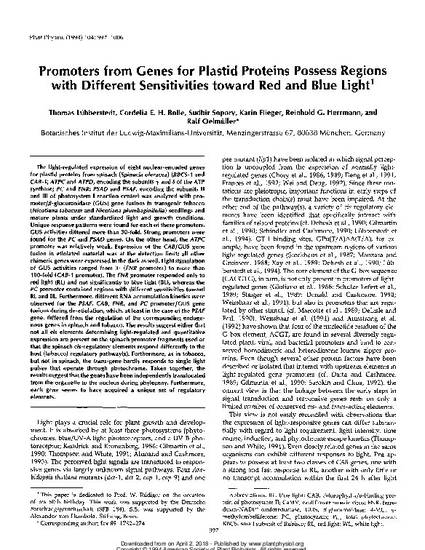
Article
Promoters from Genes for Plastid Proteins Possess Regions with Different Sensitivities toward Red and Blue Light
Plant Physiology
(1994)
Abstract
The light-regulated expression of eight nuclear-encoded genes for plastid proteins from spinach (Spinacia oleracea) (RBCS-1 and CAB-1; ATPC and ATPD, encoding the subunits [gamma] and [delta] of the ATP synthase; PC and FNR; PSAD and PSAF, encoding the subunits II and III of photosystem I reaction center) was analyzed with promoter/[beta]-glucuronidase (GUS) gene fusions in transgenic tobacco (Nicotiana tabacum and Nicotiana plumbaginifolia) seedlings and mature plants under standardized light and growth conditions. Unique response patterns were found for each of these promoters. GUS activities differed more than 30-fold. Strong promoters were found for the PC and PSAD genes. On the other hand, the ATPC promoter was relatively weak. Expression of the CAB/GUS gene fusion in etiolated material was at the detection limit; all other chimeric genes were expressed in the dark as well. Light stimulation of GUS activities ranged from 3- (FNR promoter) to more than 100-fold (CAB-1 promoter). The FNR promoter responded only to red light (RL) and not significantly to blue light (BL), whereas the PC promoter contained regions with different sensitivities toward RL and BL. Furthermore, different RNA accumulation kinetics were observed for the PSAF, CAB, FNR, and PC promoter/GUS gene fusions during de-etiolation, which, at least in the case of the PSAF gene, differed from the regulation of the corresponding endogenous genes in spinach and tobacco. The results suggest either that not all cis elements determining light-regulated and quantitative expression are present on the spinach promoter fragments used or that the spinach cis-regulatory elements respond differently to the host (tobacco) regulatory pathway(s). Furthermore, as in tobacco, but not in spinach, the trans-gene hardly responds to single light pulses that operate through phytochrome. Taken together, the results suggest that the genes have been independently translocated from the organelle to the nucleus during phylogeny. Furthermore, each gene seems to have acquired a unique set of regulatory elements.
Disciplines
Publication Date
1994
DOI
10.1104/pp.104.3.997
Publisher Statement
Copyright © 1994 by American Society of Plant Biologists
Citation Information
Thomas Lubberstedt, Cordelia E. H. Bolle, Sudhir Sopory, Karin Flieger, et al.. "Promoters from Genes for Plastid Proteins Possess Regions with Different Sensitivities toward Red and Blue Light" Plant Physiology Vol. 104 (1994) p. 997 - 1006 Available at: http://works.bepress.com/thomas-lubberstedt/77/
